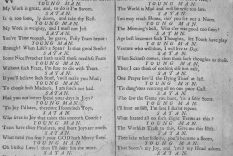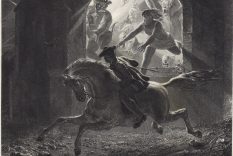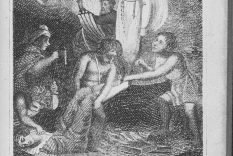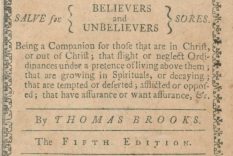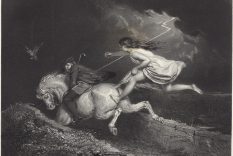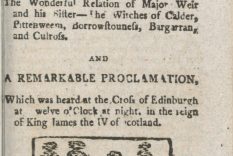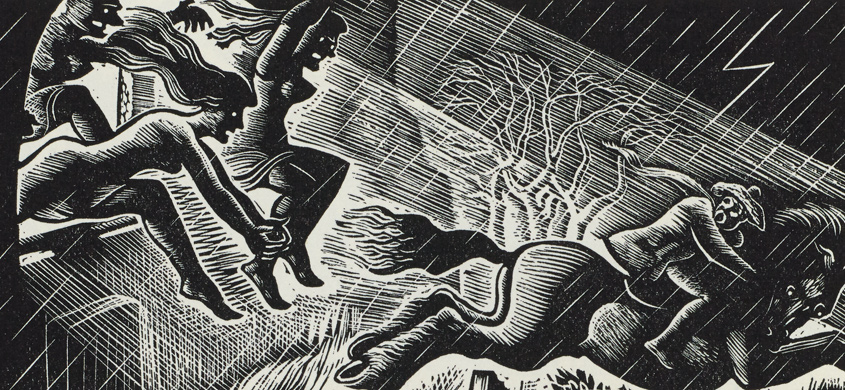
‘The Devil In Scotland, being 4 great Scottish stories of diablerie along with an introductory essay and thirty nine original wood engravings’, imprentit in 1934, wis editit an illustratit bi Douglas Percy Bliss.
These fower eldritch tales are scrievit in a fouthie Scots narrative bi three o Scotland’s best kent writers. These are Burns’s faur-famed ‘Tam o’ Shanter’, ‘Wandering Willie’s Tale’ frae Walter Scott’s novel ‘Redgauntlet’, an twa tales bi Robert Louis Stevenson – ‘Thrawn Janet’ an ‘The Tale of Tod Lapraik’.
A copy o ‘Tam o’ Shanter’ is part o the Glenriddel manuscript collection haudit at the Naitional Leebrar o Scotland. The Leebrar also hauds the manuscript copy o Scott’s novel ‘Redgauntlet’ an a copy o ‘The Cornhill Magazine’ whaur Stevenson’s ‘Thrawn Janet’ wis first imprentit in 1881. Thair is also an 1893 original copy o Stevenson’s ‘Catriona’, the lesser kent sequel tae its forerunner ‘Kidnapped’ which features ‘The Tale of Tod Lapraik’.
Lear mair aboot The Deil in Scotland
While the renouned triumvirate o Scottish literature need scant introduction, Douglas Percy Bliss’s weel-informed introduction tae ‘The Devil in Scotland’ reenges through a mettlesome history o witchcraft in Scotland, whiles it meets wi a wheen o ne’er-dae-weels an political strauchles alang the wey, gien a bit context tae the antrin tales o Burns, Scott an Stevenson waein its pages.
In this introduction, agin the backdrap o the Reformation, throu an age whan suspectit carlins wir bein herried an red oot, on intae the skaith o the 17th century Killin Times, we meet wi some kenspeckle worthies frae the daurker pages o Scottish history. Amang thaim are the demonic Richard Scott, we lear o King James VI an his execution o the Berwick carlins, an meet wi the self-proclaimit incestuous, bestial warlock Major Weir. Major Weir is the name gien tae Redgauntlet’s malcontentit pet ape in Scott’s ‘Wandering Willie’s Tale’. Amang this firbodin historical landscape lours the fearfu shadda o Auld Clootie, or Auld Nick, as the deil himsel is either weys kent.
Follaein hauf-gypit Tam astride his faithful cuddy Meg on his carrant frae the Ayr howf tae the ghaistly scenes at Kirk Allowa, ‘Tam o’ Shanter’ is aiblins the best kent an maist aften recitit eldritch tale in Scotland. Scott’s ‘Wandering Willie’s Tale’ follaes the haurd-pressed fate o Piper Steenie at the wheems o the carnaptious lairds o Redgaunlet at the hin-end o the Covenantin days. ‘Thrawn Janet’ an ‘Tod Lapraik’ are twa o Stevenson’s mair unco stories an are braw exaumples o his mair susteened prose warks in Scots. The former stairts wi a passage in English afore chyngin ower tae the narrator’s Scots.
Editor Bliss gies comment on the Scots leid yaised in Stevenson’s ‘Thrawn Janet’ an ‘Tod Lapraik.’
‘How wisely he chose the vernacular from the mouths of lowland peasants as his literary speech, for Lowland Scots is not only a beautiful but an extremely rich and expressive tongue, with a tang of the earth in it, a quality of music which cannot be translated.’
In a letter o 1880 tae American scriever an editor Charles Warren Stoddard, Stevenson heezes up the Scots leid in verse:
‘Of a the lingo’s ever prentit
The braidest Scot’s the best inventit,
Since, Stoddard, by a straik o God’s
The mason-billies cuist their hods,
And a’ at ance began to gabble
Aboot the unfeenished wa’s o Babel’
Shakespeare himsel (in Henry Fift):
‘To clerk the Lallans made a shift;
An Homer’s aft been heard tae mane;
‘Waesucks, could I but live again!
Had I the Scottish language kenn’t
I wad hae clerk’t the Iliad in’t.’
‘The Devil in Scotland’ maks fir a haundy companion tae the Scots leid. It aiblins gies a glisk o the potential o Scots had it bluimed ower time as prose literatur an nae jist been uphaudit ower a time in poetry an sang.
‘The Devil In Scotland, being 4 great Scottish stories of diablerie along with an introductory essay and thirty nine original wood engravings’, published in 1934, was edited and illustrated by Douglas Percy Bliss.
These four supernatural tales are written in a rich Scots narrative by three of Scotland’s best known writers. These are Burns’s famed ‘Tam o’ Shanter’, ‘Wandering Willie’s Tale’ from Walter Scott’s novel ‘Redgauntlet’, and two tales by Robert Louis Stevenson – ‘Thrawn Janet’ and ‘The Tale of Tod Lapraik’.
A copy of ‘Tam o’ Shanter’ is part of the Glenriddel manuscript collection held at the National Library of Scotland. The Library also holds the manuscript copy of Scott’s novel ‘Redgauntlet’ and a copy of ‘The Cornhill Magazine’ which first published Stevenson’s ‘Thrawn Janet’ in 1881. There is also an 1893 original copy of Stevenson’s ‘Catriona’, the lesser known sequel to its forerunner ‘Kidnapped’ which features ‘The Tale of Tod Lapraik.’
Learn more about The Deil in Scotland
While the renowned triumvirate of Scottish literature need little introduction, Douglas Percy Bliss’s well-informed introduction to ‘The Devil in Scotland’ ranges through a troublesome history of witchcraft in Scotland while it meets with a number of villains and political upheavals along the way, giving some context to the peculiar tales of Burns, Scott and Stevenson within its pages.
In this introduction, against the backdrop of the Reformation, through an age when suspected witches were being persecuted and driven out, on into the troubles of the 17th century Killing Times, we meet with some familiar characters from the darker pages of Scottish history. Among these are the demonic Richard Scott, King James VI and his execution of the Berwick witches as well as the self-proclaimed incestuous, bestial warlock Major Weir. Major Weir is the name given to Redgauntlet’s malcontented pet ape in Scott’s ‘Wandering Willie’s Tale’. Among this foreboding historical landscape lurks the frightful shadow of Auld Clootie or Auld Nick, as the devil himself is in either case known.
Following foolish Tam astride his faithful horse Meg on his journey from the Ayr hostelry to the ghoulish scenes at Kirk Alloway, ‘Tam o’ Shanter’ is perhaps the best known and most frequently recited supernatural story in Scotland. Scott’s ‘Wandering Willie’s Tale’ follows the hard-pressed fate of Piper Steenie at the whims of the wild and obstreperous proprietors of Redgaunlet at the closing end of the Covenanting days. ‘Thrawn Janet’ and ‘Tod Lapraik’ are two of Stevenson’s stranger tales and are fine examples of his more sustained prose works in Scots. The former starts with a passage in English before switching over to the narrator’s Scots.
Editor Bliss provides comment on the Scots language in Stevenson’s ‘Thrawn Janet’ and ‘Tod Lapraik.’
‘How wisely he chose the vernacular from the mouths of lowland peasants as his literary speech, for Lowland Scots is not only a beautiful but an extremely rich and expressive tongue, with a tang of the earth in it, a quality of music which cannot be translated.’
In a letter of 1880 to American author and editor Charles Warren Stoddard, Stevenson praises the Scots language in verse:
‘Of a the lingo’s ever prentit
The braidest Scot’s the best inventit,
Since, Stoddard, by a straik o God’s
The mason-billies cuist their hods,
And a’ at ance began to gabbl
Aboot the unfeenished wa’s o Babel’
Shakespeare himsel (in Henry Fift):
‘To clerk the Lallans made a shift;
An Homer’s aft been heard tae mane;
‘Waesucks, could I but live again!
Had I the Scottish language kenn’t
I wad hae clerk’t the Iliad in’t.’
‘The Devil in Scotland’ makes for a useful companion to the Scots language. It perhaps gives a glimpse of the potential of Scots flourishing over time as prose literature and not only prevailed over a time in poetry and song.
- Author:
- Douglas Percy Bliss
- Publication Date:
- 1934
- Imprentit:
London
‘Thrawn Janet’ by Robert Louis Stevenson
When folk told him that Janet was sib to the de’il, it was a’ superstition by his way of it; an’ when they cast up the Bible to him an’ the witch of Endor, he wad threep it doun their thrapples that thir days were a’ gane by, an the deil was mercifully restrained.
Frae ‘Thrawn Janet’ bi Robert Louis Stevenson


